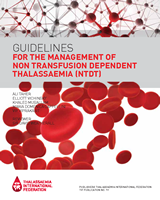All rights reserved. The publication contains the collective views of an international group of experts and does not necessarily represent the decisions or the stated policy of the Thalassaemia International Federation.
NCBI Bookshelf. A service of the National Library of Medicine, National Institutes of Health.
Taher A, Vichinsky E, Musallam Ket al., authors; Weatherall D, editor. Guidelines for the Management of Non Transfusion Dependent Thalassaemia (NTDT) [Internet]. Nicosia (Cyprus): Thalassaemia International Federation; 2013.
This publication is provided for historical reference only and the information may be out of date.

Guidelines for the Management of Non Transfusion Dependent Thalassaemia (NTDT) [Internet].
Show detailsThe term thalassaemia intermedia describes a form of thalassaemia of intermediate severity between the major, transfusion-dependent forms of the disease and the symptomless carrier states. The term includes many different varieties of thalassaemia including the compound heterozygous state for mild and severe beta thalassaemia mutations or forms of homozygous beta thalassaemia in which genetic modifiers have reduced the severity of the disease, diseases like haemoglobin E beta thalassaemia due to the co-inheritance of a structural haemoglobin variant with beta thalassaemia, the compound heterozygous states for other structural variants such as haemoglobins S or C and beta thalassaemia and a heterogeneous group of forms of alpha thalassaemia that produce haemoglobin H disease of varying severity. The wide clinical variability of these conditions leads to major difficulties in their management. These problems have been magnified over recent years by the discovery that in many forms of thalassaemia intermedia there are a wide range of complications which tend to occur later in the lives of affected patients.
In the various sections of these Guidelines the pathophysiology of these conditions is described briefly and then there follows a detailed description of how they are best managed and, in particular, the complications that have to be both looked for and dealt with later in the lives of many patients with these disorders.
These Guidelines should be of great value to anybody who has patients with these complex disorders under their care.
David Weatherall
Weatherall Institute of Molecular Medicine
University of Oxford
- FOREWORD FROM PROFESSOR SIR DAVID WEATHERALL - Guidelines for the Management of ...FOREWORD FROM PROFESSOR SIR DAVID WEATHERALL - Guidelines for the Management of Non Transfusion Dependent Thalassaemia (NTDT)
Your browsing activity is empty.
Activity recording is turned off.
See more...
